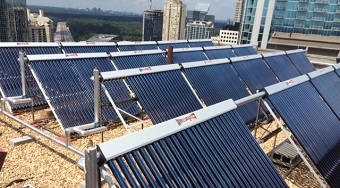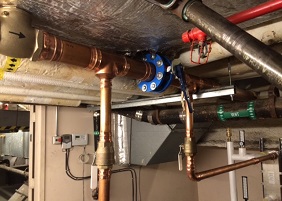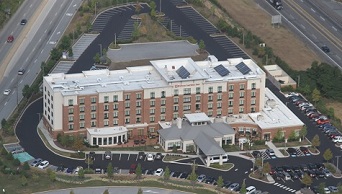
NATIONAL REPORT—Hotels and resorts around the planet are utilizing the sun’s infrared radiation and ultraviolet (UV) rays to preheat and heat water for on-property consumption—the Marriott Hotel Port-au-Prince in Haiti, the Brando in Tetiaroa, French Polynesia, the Grand Hyatt Atlanta in Buckhead, and the Hilton Garden Inn Exton/West Chester in Exton, Pa. are some examples. Not all properties use the same technology but they share the benefits of an ROI that can be relatively quick—in just a few years or less with incentives or rebates factored in. Solar water heating systems can also significantly extend the life of boilers that are used less often.
When asked what has happened in recent years to make solar for water heating a good option, William Chen, COO and VP of Engineering for Adroit Energy, said, “Proper implementation such as correct sizing of systems, choosing long lasting materials, and comprehensive installation training has helped ensure that owners receive a system that is working properly and lasts through the expected 25 year system life expectancy. Costs have not necessarily gone down in recent years due to increases in commodity prices such as copper for the piping and collectors. Larger installations may see some reduced costs due to economies of scale.”
There are two primary solar water heating system types used with commercial buildings—evacuated tube and flat plate. “Flat plate collectors are more commonly used in warmer moderate climates and evacuated tube collectors are more commonly used in much colder climates with snow and long seasons of overcast weather,” Chen says. “Because these systems are sized for annual production, a computer simulation such as a T*SOL simulation ran by a qualified design engineer would be the best method to determine which would result in the most production. An advantage of evacuated tubes includes the ability to move them to the roof through standard elevators. Commercial sized flat plate collectors are typically craned up to the roof. Costs may vary greatly between different manufacturers for each type of collector and there is no clear winner. It is strongly recommended to consult with a professional solar thermal designer to design a system with the best financial proforma.”

Dave Crawmer, President & CEO, Solar America Solutions, says his company’s evacuated tube system utilizes the sun’s UV rays. “The most potent rays are the ultraviolet,” Crawmer says. “They are out there in cloudy weather. The outdoor temperature does not matter.” Cylindrical vacuum tubes, in contrast with the flat panel designs, allow UV rays to penetrate the collector from all angles. They are attracted to the sputtered aluminum coating on the inner collection tube, where they bounce around creating friction and heat. Each collector panel consists of 25 evacuated tubes over a 21 square foot area. According to Solar America Solutions, its SunQuest 250 system produces up to 300,000 BTUs per solar day or 30,000 BTUs per hour, up to 10 times more than competitive solar panels.
The temperature inside a SunQuest 250 tube can reach 495 degrees. A heat-transfer fluid, consisting of a mixture of water and food grade glycol, conducts the collected heat out of the SunQuest 250 collector panel, through a closed hydronic loop, and into the building. The fluid in the heat pipe always remains in the pipe; only the BTUs are transferred across the system header. This allows each tube and its related components to operate independently of one another. Once inside the building, the heat is transferred to the application using various types of heat exchangers. Solar tank, plate and frame, and shell and tube heat exchangers are all common methods.
The thermal energy can be used for high volume water heating, domestic hot water (DHW), and preheat make-up water for steam applications. Space heating is accomplished by tying into traditional HVAC equipment, boiler, or radiant floor systems. Crawmer says his company is currently exploring the utilization of its technology for absorption chilling.
Grand Hyatt Buckhead Installation
In July 2016, the 439-room Grand Hyatt Atlanta in Buckhead installed a 20-panel SunQuest 250 system on its roof. Fortunately for the hotel, its boilers for domestic hot water are located just 10 feet from the roof. Three heat exchangers transfer heat from the solar water heating system into the boilers. “We put our heat exchanger in the water stream before the boilers,” says Solar America Solutions’ Don Crawmer, Vice President, Research & Development.
Wes Shirley, Director of Engineering at the Grand Hyatt Atlanta in Buckhead, has been very happy with the SunQuest 250 system.
“We did it because it was the right thing to do and there was a reasonable ROI—a little more than three years,” Shirley says. “We used to get guest calls about hot water. We have not had a single hot water call since we installed it. “The boilers only fire up on the weekends or during very busy times. We used to have a boiler company come out every three months. We have not had to call them a single time.” Shirley adds that the system has a 25-year life expectancy.
Flat Plate Example in Pennsylvania
At the end of 2013, the five-story Hilton Garden Inn Exton/West Chester in Exton, Pa. had a 21-panel solar water heating system installed on its roof. Hankin Group, owner of the property, had the system put in as part of an effort to achieve LEED Silver certification. The solar thermal system provides a portion of the property’s domestic hot water. Water pumped through the network of glass tubes in the rooftop panels collects the sun’s heat. The solar heated water is stored in a 1,500 gallon storage tank which supplies preheated water to the hotel’s conventional gas water heaters. The system offsets 25 percent of the hotel’s water heating costs for domestic hot water.

Lance Hillegas, Vice President of Design and Sustainable Development for Hankin Group, which owns the hotel, says the solar water heating system has been problem free. The hotel includes it in its marketing materials as part of its larger green story. “There is a segment of the corporate business crowd that reaches out to green certified hotels,” Hillegas says.
For the last five years all domestic hot water at The Cliff House Resort & Spa in Cape Neddick, Maine has been heated using a solar water heating system featuring evacuated tubes. “There is no maintenance to the system,” says Sonny Cataldo, Director of Engineering at the 132-room property. The installation complements the resort’s other green initiatives: energy efficient lighting, natural cork flooring in the spa, organic fertilizers and the use of fresh, locally grown and raised ingredients in its restaurants.
In Tetiaroa, French Polynesia, all of the Brando’s hot water is provided thanks to thermal solar collectors. In Haiti, 60 percent of the Marriott Port-au-Prince Hotel’s hot water supply is provided through thermal solar panels installed on its roof. At the LEED Platinum Proximity Hotel in Greensboro, N.C., a 100-panel solar water heating system heats more than half of the hotel’s water.
A Scalable Water Heating Solution
Solar America Solutions’ Dave Crawmer says solar water heating systems are very scalable. His company has installed systems on buildings ranging from a Super 8 to a large prison complex. “The only restriction is the amount of square footage available for the panels,” he says. “You also need to have access to your mechanical room. We can hook them up in a series or parallel.”
Local or state incentives vary for the systems. Says Adroit Energy’s Chen, “The incentives that should be sought after would be the CSI-Thermal Incentive for the California region and the Federal Investment Tax-Credit. With these two incentives combined, along with the MACRS depreciation, the solar hot water system should have a very attractive proforma. Commercial PACE financing is available in some regions. In some cases it is also possible for the contractor to factor the rebate, which significantly reduces up-front cash required. If there are limited funds, a TESA (Thermal Energy Service Agreement) or thermal PPA (Power Purchase Agreement) may be a great option. With any of these choices, these systems have shown very exciting ROI’s.”
When asked what hoteliers should look for when considering a solar hot water heating system, Dave Crawmer said, “Ask for references. Ask the people who write the checks.” Adds Solar America Solutions’ Don Crawmer, “Ask how many BTUs/hour it produces and for how many hours a day. Also, ask about SRCC (Solar Rating & Certification Corp.) certification. You can’t get the 30 percent federal tax credit without it.”
Chen says, “My recommendation for hoteliers would be to find a reputable and licensed solar thermal contractor with a large portfolio of successful commercial projects.”
Glenn Hasek can be reached at editor@greenlodgingnews.com.





